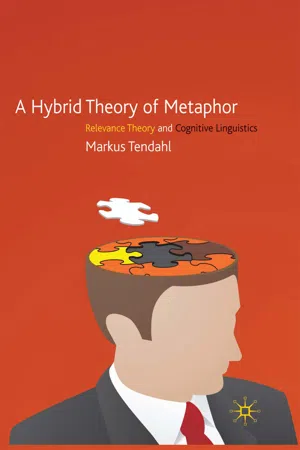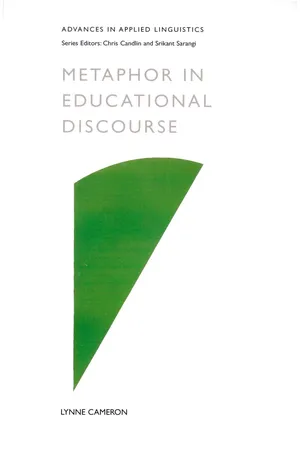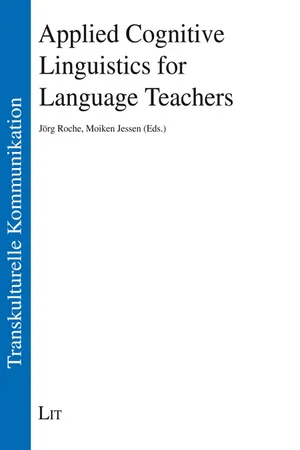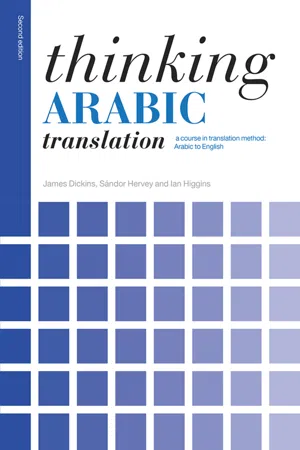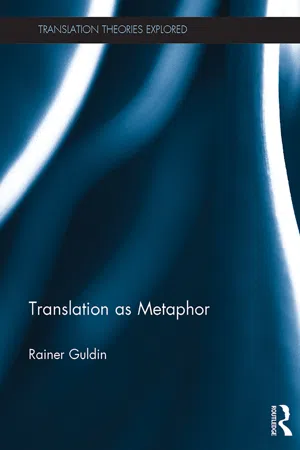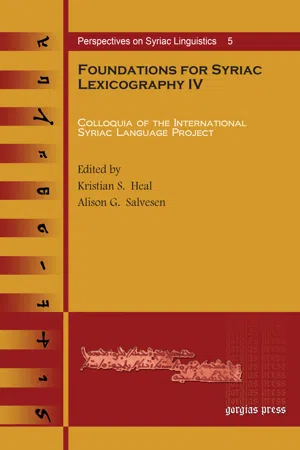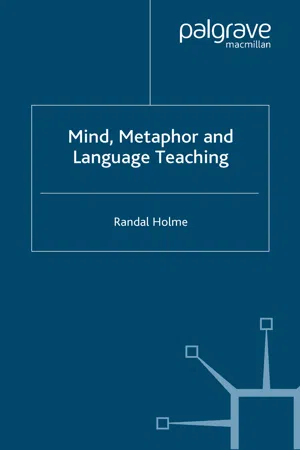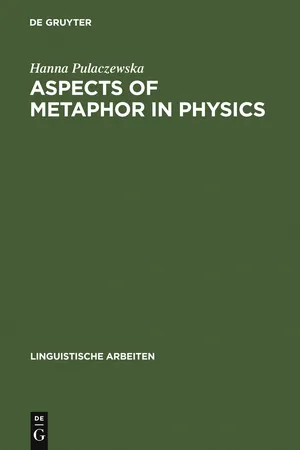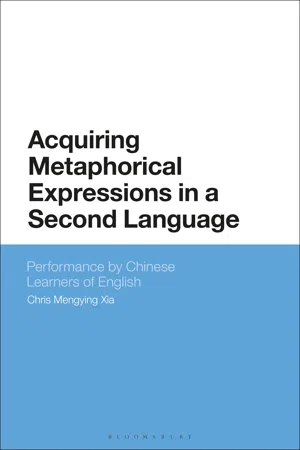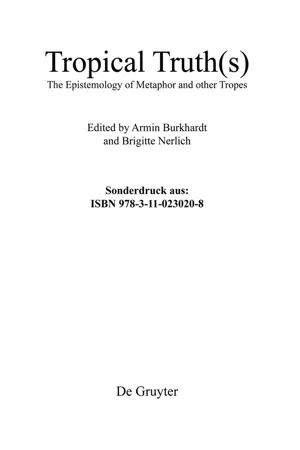Languages & Linguistics
Metaphor
A metaphor is a figure of speech that describes a subject by asserting that it is, on some point of comparison, the same as another otherwise unrelated object. It is used to make a comparison between two things that are not alike but do have something in common. Metaphors are widely used in literature and everyday language to create vivid imagery and convey complex ideas.
Written by Perlego with AI-assistance
Related key terms
1 of 5
12 Key excerpts on "Metaphor"
- eBook - PDF
A Hybrid Theory of Metaphor
Relevance Theory and Cognitive Linguistics
- M. Tendahl(Author)
- 2009(Publication Date)
- Palgrave Macmillan(Publisher)
On the one hand, these ideas are also the basis for the treatment of meta- phor in cognitive linguistics. On the other hand, many of the defining assumptions of the cognitive linguistics programme result from research on Metaphor. 3.2 Metaphor as conceptualization: conceptual Metaphor theory Modern theories of Metaphor have refuted the notion that Metaphor com- prehension requires special processes which are only triggered off when a defect has been found in the standard literal processing mechanism. Nowadays, Metaphor is regarded to be a central aspect in theories of human communication and cognition. Lakoff and Johnson (1980: 3) observe that ‘Metaphor is pervasive in everyday life, not just in language but in thought and action’. Many abstract or complex concepts that we encounter every day, like time, love, states, changes, war, etc., are mentally represented, under- stood and constituted by Metaphor. The importance of Metaphor for cogni- tion, as opposed to language, becomes apparent when Lakoff and Johnson (1980: 153) say that ‘Metaphor is primarily a matter of thought and action and only derivatively a matter of language’. Thus, the total significance of Metaphors only unveils itself when Metaphors are not regarded as defective parts of language, but rather as tools to conceptualize one mental domain in terms of another. Metaphor is fundamentally a kind of mental mapping and neural coactivation from which certain patterns of conventional and novel Metaphorical language arise and which influences how people think, rea- son and imagine in everyday life (Lakoff 2008; Lakoff and Johnson 1999). Conceptual Metaphor theory distinguishes between the words Metaphor and Metaphorical expression. The term Metaphor is defined as ‘a cross-domain mapping in the conceptual system’ (Lakoff 1993: 203). The term mapping Cognitive Linguistics and Metaphor 115 comes from the nomenclature of mathematics. - eBook - PDF
- Lynne Cameron(Author)
- 2003(Publication Date)
- Continuum(Publisher)
Metaphor, as 'a figure of speech', is primarily a linguistic phenomenon. All linguistic meta-phors are presupposed to function as process Metaphors, so that the two categories are collapsed into one. SUBSTITUTION THEORY The Substitution theory of Metaphor, often claimed to be directly descended from Aristotelian theory, but, as I have suggested, actually a misrepresentation of it, characterizes Metaphor as 'renaming' of the Topic by the Vehicle: Metaphor is the application to one thing of the name belonging to another. (Aitchison 1987: 144) Metaphor: A rhetorical figurative expression of similarity or dissimilarity in which a direct, nonliteral substitution or identity is made between one thing and another. (Myers and Simms, Longman Dictionary of Poetic Terms 1982) The Substitution theory would thus see the example the atmosphere is a blanket of gases as a renaming, or substitution, of atmosphere with the term blanket. The idea of mapping across conceptual domains is reduced to the linking of concepts or entities, with the relations in the domains left out of the picture. 15 Metaphor in educational discourse In this simplified view of how Metaphor works, the sentence containing blanket is held to be replacing some set of literal sentences (Black 1979: 27). The principle that a literal equivalent of a Metaphor can be found and will work as a paraphrase of it, also entails that Metaphor is decorative and can be dispensed with, without any loss of meaning. For those who see Metaphor as creative and essentially irreducible, this principle and its entailments lie at the heart of the weakness of the Substitution theory. It is further weakened if Metaphor is characterized as renaming, which focuses attention on nominal Metaphors to the neglect of other types, particularly verb Metaphors. - Jorg Roche, Moiken Jessen(Authors)
- 2023(Publication Date)
- LIT Verlag(Publisher)
96 3.1 Linguistic Imagery and the Conceptual Metaphor Natalya Furashova, Moiken Jessen & Katsiaryna EL-Bouz Sometimes, people are not straightforward with what they mean to say, and – on the other hand – words are not always used to express their literal meaning. We could, for instance, say about a person that he is cun- ning or clever. But instead, we say He’s (sly as) a fox. We harbor certain mental images (such as a mental image of a fox) and use them to speak about different things. The transfer entails a special effect which origi- nates from linguistic imagery. Linguistic imagery is mainly achieved by Metaphors and metonymies. These used to be viewed as primarily rhetoric tropes and, therefore, ap- peared to be of relevance primarily to rhetorics and to literature rather than to linguistic research. Furthermore, they were viewed as purely sty- listic phenomena. This chapter focuses on Metaphors and broadens the traditional under- standing of Metaphors using research results of cognitive linguistic stud- ies. According to these results, Metaphors are an expression of our intel- lectual abilities and, therefore, constitute the cognitive foundation of lan- guage. They exhibit a regular, systemic character and embody a concep- tualizing mechanism, or in other words, a pattern of thought. Study Goals By the end of this chapter, you will be able to: − explain the most important types of figurative language − recognize different aspects of transmitting meaning − comprehend the difference between Metaphor and metonymy from the perspective of traditional linguistics − gain a first impression of the Metaphor as a cognitive, conceptu- alizing mechanism which structures language. 97 3.1.1 The Basics: Types of Imagery-Based Languages Using words in a non-literal sense was part of the art of oratory (rhetorics) in antiquity.- eBook - PDF
Thinking Arabic Translation
A Course in Translation Method: Arabic to English
- James Dickins, Sándor Hervey, Ian Higgins(Authors)
- 2016(Publication Date)
- Routledge(Publisher)
According to Newmark, ‘Whilst the central prob-lem of translation is the overall choice of a translation method for a text, the most important particular problem is the translation of Metaphor’ (Newmark 1988: 104). Metaphor can give rise to dif fi culties in translation between any two languages, but where the languages concerned are as relatively different culturally and linguisti-cally as English and Arabic, the dif fi culties are sometimes quite pronounced. For an introduction to the other fi gures of speech, see Abrams (1985). For further discussion of issues in Metaphor translation, see Schäffner (2004) and Dickins (2005). 14.2 General de fi nition of Metaphor Metaphor can be de fi ned as a fi gure of speech in which a word or phrase is used in a non-basic sense, this non-basic sense suggesting a likeness or analogy with Metaphor 14 Metaphor 195 another more basic sense of the same word or phrase. Consider the fi rst two senses of ‘rat’ given in the Collins English Dictionary : (i) ‘any of numerous long-tailed murine rodents, esp. of the genus Rattus, that are similar to but larger than mice and are now distributed all over the world’ and (ii) ‘a person who deserts his friends or associates, esp. in times of trouble’. Here, each sense of ‘rat’ may be said to call to mind the other (although the fi rst would in most contexts only weakly call to mind the second). That is to say, any use of ‘rat’ in a particular text has the potential to invoke a re fl ected meaning. However, ‘rat’ in the sense of ‘a person who deserts his friends or associates’ is a Metaphor with respect to ‘any of numer-ous long-tailed murine rodents’. By contrast, ‘rat’ in the sense of ‘any of numerous long-tailed murine rodents’ is not a Metaphor with respect to ‘a person who deserts his friends or associates’. This is because we perceive the sense of ‘rat’ ‘any of numerous long-tailed murine rodents’ as being more basic than the sense ‘a person who deserts his friends or associates’. - eBook - ePub
- Rainer Guldin(Author)
- 2015(Publication Date)
- Routledge(Publisher)
Metaphors are also of great importance in theory change. Paradigmatic shifts go hand in hand with a radical transformation of the Metaphorical metalanguage of a specific scientific domain. Finally, Metaphors are essential to the transmission of scientific theory. Traditional Metaphors have a powerful influence on the ways in which a theoretical field is perceived. In the wake of a paradigmatic shift, new Metaphors can be used to convince others to adopt the consequences resulting from the theoretical change. Textbooks written for pedagogical purposes generally adopt these Metaphors after a new paradigm has been accepted (St. André 2010a: 5). Let me now turn to the definition of Metaphor in cognitive linguistics. 7 Lakoff and Johnson on Conceptual Metaphors George B. Lakoff, Professor of Linguistics at the University of California since 1972, and Marc Johnson, from the department of philosophy at the University of Oregon, radically redefined the field of Metaphor theory in cognitive terms. Cognitive linguistics defines linguistic phenomena as fundamentally conceptual in nature. Language and cognition mutually influence each other. Language is, furthermore, embodied and always situated within a specific environment. In Metaphors We Live By, Lakoff and Johnson define Metaphors as the very basis of everyday action and thought. “Metaphor is for most people a device of the poetic imagination and rhetorical flourish – a matter of extraordinary rather than ordinary language. Moreover, Metaphor is typically viewed as characteristic of language alone, a matter of words rather than thought and action … We have found, on the contrary, that Metaphor is pervasive in everyday life, not just in language but in thought and action. Our ordinary conceptual system, in terms of which we both think and act, is fundamentally Metaphorical in nature” (Lakoff and Johnson 2003: 3) - eBook - PDF
Foundations for Syriac Lexicography IV
Colloquia of the International Syriac Language Project
- Kristian S. Heal, Alison G. Salvesen(Authors)
- 2014(Publication Date)
- Gorgias Press(Publisher)
13 8 Crystal, A Dictionary of Linguistics & Phonetics , 80. 9 Lakoff and Johnson, Metaphors We Live By , Afterword, 270. 10 Lakoff and Johnson, Metaphors , 4. 11 Lakoff and Johnson, Metaphors , 3. 12 Lakoff and Johnson, Metaphors, Afterword , 239. 13 Lakoff and Johnson, Metaphors , 6. M ETAPHOR , L EXICOGRAPHY AND M ODERN L INGUISTICS 27 Lakoff and Turner reinforced this thesis in More than Cool Reason in which they emphasize that their theory is not restricted to so-called “Metaphors,” for “it could be the case that every word or phrase in a language is defined at least in part Metaphorically.” 14 As the authors are aware, the implications of this claim are far reaching; they ripple from the centre to the far edges of this essay’s concern. It should therefore be noted that the concept that “every word or phrase in a language” might be Metaphoric has a fascinating antecedent. Twenty years earlier, Marshall McLuhan wrote: All media are active Metaphors in their power to translate experience into new forms. The spoken word was the first technology by which man was able to let go of his environment in order to grasp it in a new way. Words are a kind of information retrieval that can range over the total environment and experience at high speed. Words are complex systems of Metaphors and symbols that translate experience into our uttered or outered senses (emphasis added). They are a technology of explicitness. By means of translation of immediate sense experience into vocal symbols the entire world can be evoked and retrieved at any instance. 15 In his 2007 publication, The Extended Mind: The Emergence of Language, the Human Mind, and Culture , Robert Logan argues that language can be treated as an organism that evolved to be easily acquired, obviating the need for the hard-wiring of Chomsky’s Language Acquisition Device. - eBook - PDF
- R. Holme(Author)
- 2003(Publication Date)
- Palgrave Macmillan(Publisher)
In the case of the French ‘going-to’ future, we understand the conceptual Metaphors that still function as active schema within us, determining why a given language will express things as it does. Conclusions In this chapter I have tried to summarise a large and complicated area of research. I began by looking at why some intellectual traditions have found Metaphor difficult, and then looked at how this difficulty trans- lates into the problem of knowing when language is or is not Metaphor- ical. I have put forward the position that there is no formal test for Metaphor and that how we judge the literalness of language is the judge- ment of a community of language users at any one time. Our concern should not be with whether Metaphors are alive, dying or dead. Metaphors can flout conventional uses of language because they create new meanings or draw attention to ones that we did not quite know were there. Metaphors can also become part of conventional language use. For this book, the main interest in new Metaphor is in how it draws attention to a wider cognitive process that is responsible for the way we conceptualise abstract meaning in language. For the language teacher, the important point that we should carry forward is that Metaphor reveals a great deal about how the mind: ● conceptualises the meanings expressed in language; ● copes with the new and the strange; and ● acquires and uses new knowledge. Metaphor cannot have serious consideration without reference to the broader areas of cognitive linguistics and cognitive science. The interest of cognitive linguists is not in language as an isolated or separate phe- nomenon that we must study for the structures or systems that we can find in it; the interest is in how language reveals the mental processes that shape it. Such a concern shifts our treatment of language from something isolated and unique towards one which understands its nature as bound up with how we learn and think. - eBook - PDF
Aspects of Metaphor in Physics
Examples and Case Studies
- Hanna Pulaczewska(Author)
- 2011(Publication Date)
- De Gruyter(Publisher)
In the Anglo-Saxon world, an early attempt to further the significance of Metaphor in common language is found in Langer (1949). Inspired by Wegener's ideas, she perceived the ubiquity of Metaphor and the process of literalisation of Metaphorical meaning: In a genuine Metaphor, an image of the literal meaning is our symbol for the figurative meaning, the thing has no name of its own... But if a Metaphor is used very often, we learn to accept the word in its Metaphorical context as though it had a literal meaning there.. .The great extent and frequen-cy of its Metaphorical services have made us aware of the basic aware of the basic concept in virtue of which it can function as a symbol in so many contexts; constant figurative use has generalised its Mauthner 1906: 120-131. Mauthner 1912: 451. ibid.: 467. ibid.: 488. Langer 1949: 113-114. 11 [...] The use of Metaphor ... is the power whereby language, even with a small vocabulary, mana-ges to embrace a multimillion things; whereby new words are bom and merely analogical meanings become stereotyped into literal definitions ... Langer's theory is closely bound with the evolution of speech, in particular with its function of giving something a name. Literal language for her is the repository of language. She argues persuasively in favour of broadening the concepts of meaning and Metaphor to include Metaphor as new meaning. Brown (1958), too, identifies Metaphor as one of the two basic forms of semantic change. All these writers recognised what today has become a matter of course: Metaphor functions in the lexicon as a process of generalising meaning change; new literary language is made by the emergence and then the dying or fading of a Metaphor. The contemporary history of Metaphor as a primarily cognitive phenomenon is frequently said to have originated with Richards' interaction view of Metaphor which he initiated and which gained currency after it was developed and popularised by Max Black some thirty years later. - eBook - PDF
Metaphor Wars
Conceptual Metaphors in Human Life
- Raymond W. Gibbs, Jr(Authors)
- 2017(Publication Date)
- Cambridge University Press(Publisher)
We simply do not yet know to what extent people always, or ever, activate what kind of conceptual information during the experience of verbal Metaphor understanding. Nonetheless, Yu’s analysis demonstrates the degree to which the understanding of simple Metaphor- ical words may be grounded in a rather rich set of non-linguistic, concep- tual knowledge, some of which arises from and continues to be rooted in 116 Inferring Conceptual Metaphors from Language embodied experience (e.g., in primary Metaphors like A FEELING IS A PHYSICAL OBJECT). People’s experience of Metaphorical meaning must include rich layers of conceptual and embodied knowledge, ranging from propositions to different sets of Metaphorical and metonymic mappings. 37 In general, there may be strong linguistic evidence that Metaphors are fundamental principles guiding the ways people speak and think of their experiences, especially those related to abstract ideas and events. However, determining the exact conceptual motivations for a particular person’s use of any verbal Metaphor likely requires evidence other than that obtained from examining systematic linguistics. the need for corpus linguistics As noted in Chapter 3, a key development in cognitive linguistic research is the emergence of corpus linguistic studies. The examination of actual language patterns, as evident from the analysis of large-scale corpora, provides a firmer basis for determining underlying conceptual Metaphors than can be provided by analyses that rely on dictionaries, thesauruses, or decontextualized verbal Metaphors. Part of the concern here is that stand- ard CMT analyses are too often based on the intuitions of individual analysts, which may be biased, inaccurate, or poor reflections of how Metaphors are really used in discourse. Do corpus studies remedy this problem? For example, Anatol Stefanowitsch described one method for inferring relevant conceptual Metaphors through the organized search of large-scale corpora. - eBook - PDF
Acquiring Metaphorical Expressions in a Second Language
Performance by Chinese Learners of English
- Chris Mengying Xia(Author)
- 2019(Publication Date)
- Bloomsbury Academic(Publisher)
In real language use, however, a polysemous word can appear with either a more concrete or a more abstract meaning, depending on the context in which it is used. This is particularly prominent in experiments wherein which the Metaphorical use and the literal use of a single word are contrasted. By definition, the Metaphorical use of a word is the linguistic outcome of mapping a concrete conceptual domain to an abstract one (Lakoff & Johnson 1980; Lakoff & Turner 1989) or, to take an Aristotelian view (Aristotle, Rhetoric III.21, 1475b1–30) the Metaphorically used word is the ‘transference’ of a concrete word to an abstract context. Both definitions indicate that when a word involves conventional uses in both a literal and a Metaphorical way, it can be linked to both concrete and abstract conceptual representations. The concrete concepts reside in their own concrete domain, associated with the literal meanings of that word, and the abstract concepts associated with the Metaphorical meanings are involved in cross-domain mapping. Therefore, it may also be expected that the processing difference between concrete and abstract words indicated in the DCFM will be replicated in the concrete and abstract meanings of a single word. De Groot, as well as Finkbeiner and colleagues, further outlines how the concreteness of words can affect the conceptual representations between a pair of translation equivalents. Although neither of them explicitly links such differences to a possible trace of cross-linguistic influence, a series of feasible connections can be made regarding the concreteness of a pair of translation equivalents, the degree of overlap in conceptual elements of that pair, and the transferability of that pair. - eBook - PDF
Tropical Truth(s)
The Epistemology of Metaphor and other Tropes
- Armin Burkhardt, Brigitte Nerlich, Armin Burkhardt, Brigitte Nerlich(Authors)
- 2010(Publication Date)
- De Gruyter(Publisher)
What is at stake then, as said before, is appropriateness, and not truth con-ditions, which appear to be insufficient for describing the complex role of Metaphor in language. Metaphor (and literal language as well) is to be taken as mainly appropriate in discourse, in its multifarious contextual constraints, as it is “[…] not an awkward way of communicating one’s convictions and beliefs (about the properties of objects) to another. […It] is, on the contrary, a very subtle means of transcending the realm of trivial everyday truth and falsehood.” (Burkhardt 1990: 320, 324) References Akman, Varol, Carla Bazzanella: “The complexity of context”, in: Akman, Varol, Carla Bazzanella (eds.): Special issue on Context, Journal of Pragmatics , 2003. Austin, John Langshaw: Philosophical Papers. London: Clarendon Press 1961. – How to Do Things with Words. Oxford: Oxford University Press 1962. Bazzanella, Carla: “On context and dialogue”, in: Cmejrkovà, Svetla et al. (eds.): Dialogue in the Heart of Europe. Tübingen: Niemeyer 1998, 407–16. – “Metaphor in classroom interaction”, in: Rigotti, Eddo (ed.): Rhetoric and Argu-mentation. Tübingen: Niemeyer, 1999a. 237–46. – “La metafora tra mente e discorso”, in: Bazzanella, Carla, Claudia Casadio: “Prospettive sulla metafora.” Lingua e stile XXXIV, 2 (1999b), 150–8. – “Metaphor and context: some issues”, in: Kronning, Hans et al. (eds.): Langage et référence. Mélanges in honour of Kerstin Jonasson. Acta Universitatis Upsaliensis: Upsala, 2001, 39–49. – “The significance of context in comprehension. The ‘ we case’”, in: Edmonds, Bruce, Varol Akman (eds.): Special issue of FOS (Foundations of science) Context in context, 7. Dordrecht: Kluwer Academic Publishers 2002, 239–54. – “Il radicamento contestuale della metafora”, in: Casadio, Claudia (ed.): Vie della metafora: linguistica, filosofia, psicologia. Sulmona: Editore Prime Vie, 2008, 79– 95. – Special issue of Paradigmi: La forza cognitiva della metafora. - eBook - PDF
Metaphor, Metonymy, and Experientialist Philosophy
Challenging Cognitive Semantics
- Verena Haser(Author)
- 2011(Publication Date)
- De Gruyter Mouton(Publisher)
Criteria for distinguishing Metaphor and metonymy 19 2.2.3 Similarity Many scholars, including some cognitive linguists, hold that Metaphors exploit similarities (e.g., Grady 1999; Feyaerts 2000). 4 Similarity is often equated with the number of attributes shared by two entities (cf. Warren 1992: 73-74; Taylor 1995: 60). The putative mental process at work in the interpretation of Metaphors has been described as a matching of source and target features. Since infinitely many attributes can be ascribed to an entity (cf. Glucksberg/Keysar 1990: 4), 5 psychological models stipulate that only a subset of these attributes are selected as figuring in the assessment of similarity (cf. Tversky 1977; Glucksberg/Keysar 1990). Classical accounts of similarity have come under strong attack in recent years, as have theories of Metaphor which postulate similarities as the all-important basis of Metaphorical transfer (cf. Paivio/Begg 1981; Paivio/Walsh 1993: 309-310; Taylor 1995: 60-62). Some of the problems raised by accounts appealing to similarity as the motivation of Metaphorical extension will be reviewed in this section. Metaphors involve similarities between dissimilar concepts. This fun-damental tension has far-reaching implications for the nature of the features shared by tenor and vehicle. As Ortony (1979: 167) notes, attributes that may be nominally the same often seem to change their meanings as they are applied to terms in different domains. Consider Black's paradigm example Man is a wolf, which transfers features of beasts {fierceness ) to human be-ings (cf. Black 1981 [1955]: 73-74). If fierceness is applied to human rela-tions, we witness a change in meaning. While wolves are fierce in the sense of 'scavenging, brutish, predatory', social relations are characterized by a different type of fierceness (e.g., aggressive competition). Tourangeau/ Sternberg (1982: 218) aptly note that the meaning of a ... feature depends in part on the domain in which it is applied.
Index pages curate the most relevant extracts from our library of academic textbooks. They’ve been created using an in-house natural language model (NLM), each adding context and meaning to key research topics.
